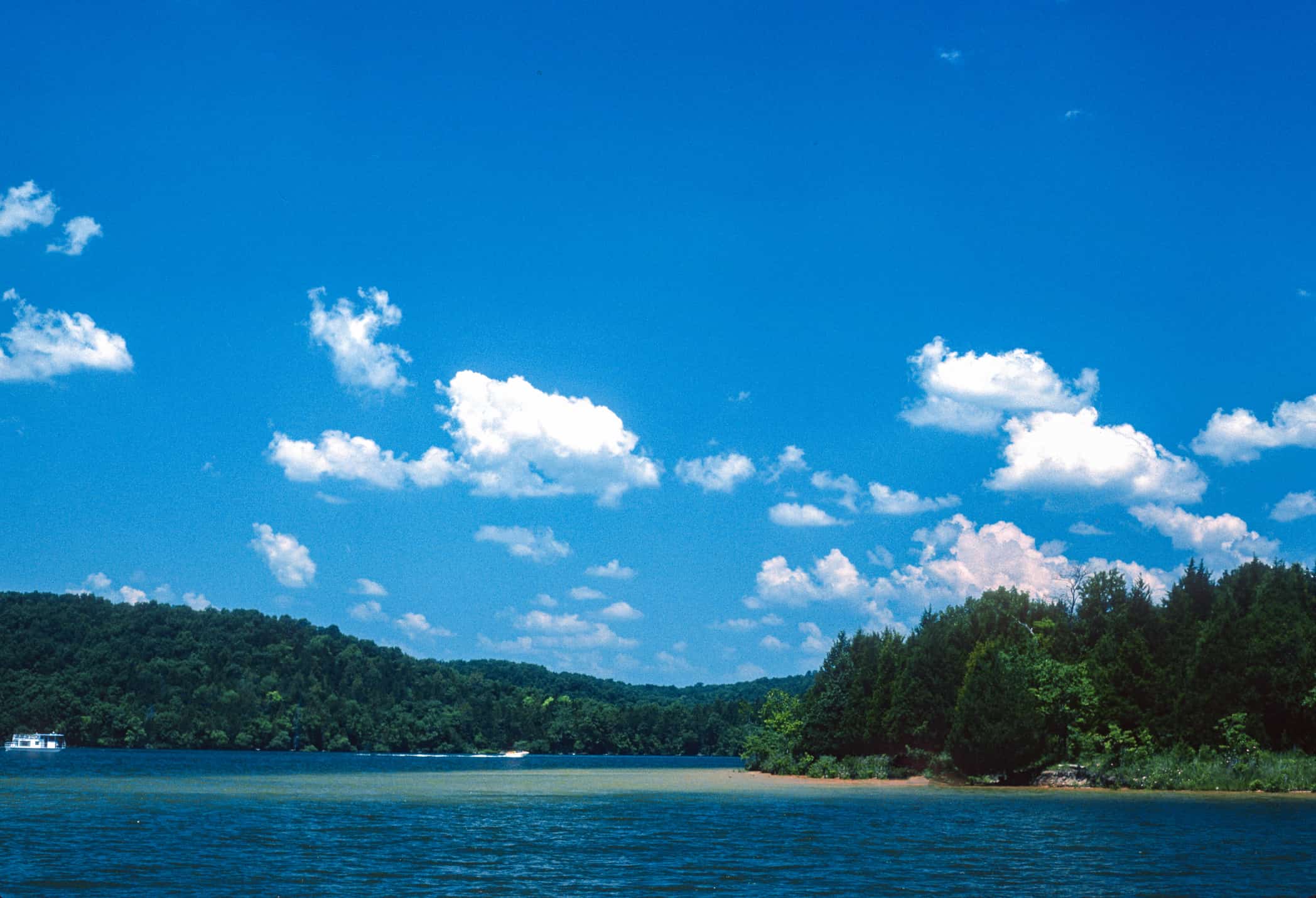Nestled in the Ozark Mountain range of Missouri, the 60th largest lake in the United States stretches seemingly as far as the eye can see. It boasts over 86 square miles of surface area and has a shoreline that stretches over 1,100 miles. You’ll learn about this lake as you read on, from wildlife in the region to the answer to the question that brought you here – how wide is the Lake of the Ozarks?
What is the Lake of the Ozarks?
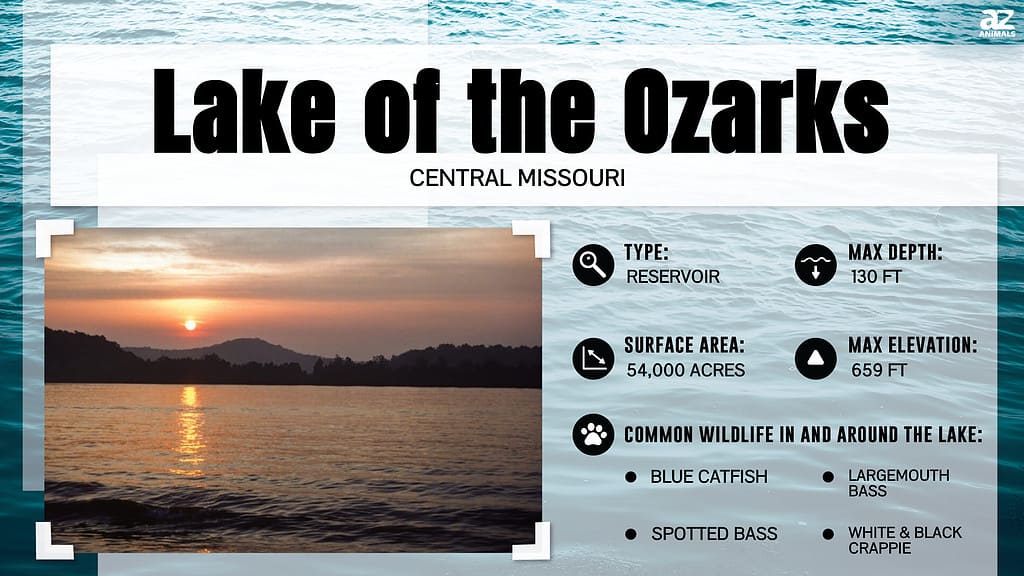
Lake of the Ozarks is a man-made reservoir that is fed mainly by the Osage River. Less than 100 years old, this massive lake is now the home of many wildlife species and a popular destination for tourists and residents alike. It is now one of the top recreational areas in the Midwest, and for good reason! There’s a ton of cool stuff to do lakeside, from fishing and camping to swimming, boating, and hiking.
Formed in 1931 as a result of the erection of the Bagnell Dam, Lake of the Ozarks and its connected lakes and riverways now draw over 5 million visitors a year. Originally built for hydroelectric power sources, it now carries a legacy vaster than sustainable energy, starting with its name.
The lake has adopted many names since its conception. Originally, construction crews for the dam called it Lake Osage, or Osage Reservoir. Later, the Missouri General Assembly honored Senator Thomas Hart Benton with the lake as his namesake, but the title ‘Lake Benton’ never stuck. Most people in the region simply referred to it in reference to its location. It rests at the northern point of the Ozarks, which is how it finally got its real name.
Building the lake did have some consequences. Several villages and towns below the dam disappeared under the waters of the new lake. This didn’t halt progress. At its beginning, Lake of the Ozarks was the largest man-made reservoir in the United States and one of the largest in the world. Now, the honor goes to Lake Mead in Nevada, but that does not change the impressive history of this lake.
How Wide is the Lake of the Ozarks?

At its widest point, the Lake of the Ozarks is nearly 1 mile wide.
©iStock.com/Perry Spring
At its widest point, the Lake of the Ozarks is nearly 1 mile wide. This is an impressive width, but not as impressive as its length. Stretching over 90 miles, the Lake of the Ozarks is the 17th longest lake in the United States. It reaches a maximum depth of 130 feet – that’s deeper than a 10-story building! While it was the largest of its time, there are now several other man-made reservoirs larger than this lake. These include Lake Mead in Nevada and Arizona with a width of 9.3 miles, a length of 120 miles, and a maximum depth of 534 feet. Lake Mead is the largest man-made reservoir in the United States.
For more comparisons, check out this table of widths, which will compare the widths of 5 different man-made reservoirs in the United States. This list includes a variety of lakes and isn’t a list of the top 5.
| Lake | State | Maximum Width |
|---|---|---|
| Beaver Lake | Arkansas | 2 miles |
| Flathead Lake | Montana | 15.47 miles |
| Lake McConaughy | Nebraska | 4 miles |
| Lake Marion | South Carolina | 8 miles |
| Lake Norman | North Carolina | 9 miles |
Is it Safe to Swim in the Lake?

Swimming in the Lake of the Ozarks is safe, but it is a good idea to check swim advisories before getting in the water.
©l i g h t p o e t/Shutterstock.com
Yes, it is safe to swim in the Lake of the Ozarks. There are plenty of beaches and recreation areas at the lake where locals and visitors can dip their toes. While the lake is often a great swimming destination, officials warn of high concentrations of the bacteria that cause E. coli in some areas of the waters. The Missouri Department of Natural Resources reminds visitors to check swim advisories before getting in the water. These swim advisories are based on the results of weekly water tests – officials take water from the lake and test it for E. coli concentrations in Jefferson City, Missouri, less than 50 miles south of the lake. There is a maximum for concentrations of E. coli, and any test that results in a number higher than this maximum means the lake is unsafe to swim in.
An advisory is not a ban – some swimmers still risk the water. Potential side effects of swimming in water with high concentrations of E. coli bacteria include stomach upset, low-grade fever, and diarrhea.
This is not unusual. Many lakes contain bacteria and algae that are harmful to humans and animals. It’s wise to check local advisories for any lakes or rivers you might visit to ensure safety and success in your swimming ventures.
Can you Swim Across the Lake of the Ozarks?
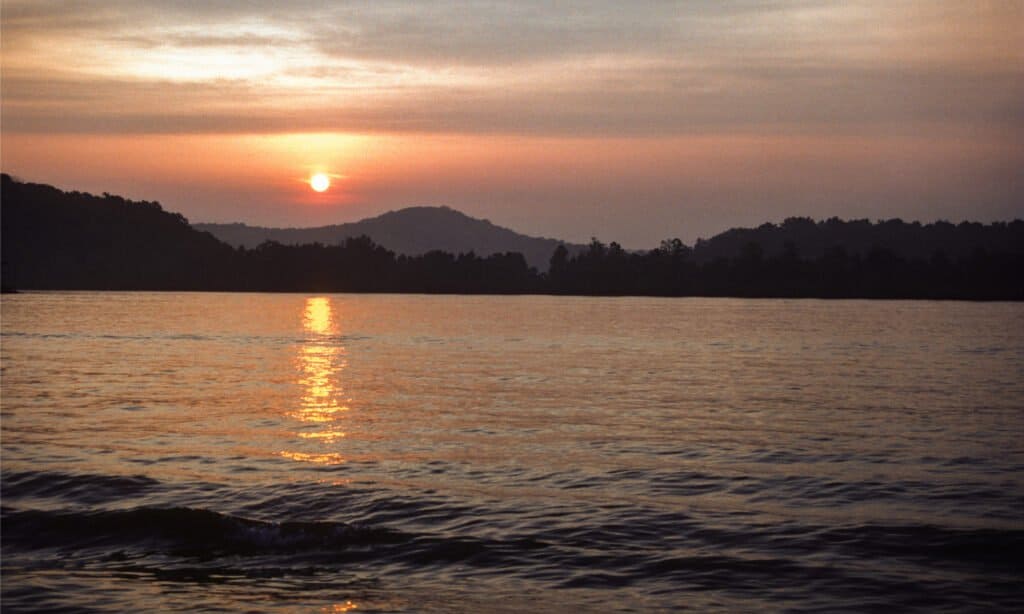
Nestled in the Ozark Mountain range of Missouri, Lake of the Ozarks is the 60th largest lake in the United States.
©iStock.com/scgerding
Could a good swimmer cross the Lake of the Ozarks at its widest point? Practically, the answer is yes. A swimmer keeping a steady speed of 2 miles per hour could feasibly cross the width of the lake in half an hour. This is nothing compared to the records for swimming length. The longest lake swim ever recorded was a whopping 104 miles, performed by Sarah Thomas on Lake Champlain in New York and Vermont. It took her over 67 hours.
No easily-accessible data exists for if anyone has ever attempted the swim.
The Osage River
The Osage River feeds the Lake of the Ozarks. Before the erection of the Bagnell Dam, the river passed through the area where the lake now rests. The river is a 276-mile-long tributary of the Missouri River. Its entirety rests in Missouri, and it is the 8th largest river in the state. It begins in southern Missouri only 14 miles from the Nevada border and meanders through the state to where it joins the Missouri River near Jefferson City. Some people include the Marais des Cygnes River in length calculations, which brings the overall length to over 500 miles. However, the Marais des Cygnes River is merely a primary tributary of the Osage River.
The historic Osage Nation is the source of the river’s name. This nation’s original name means “People of the Middle Waters” and the nation itself dates back to 700 B.C. or before. “Osage” is a French interpretation of the nation’s name, and it means “calm water”.
The Bagnell Dam
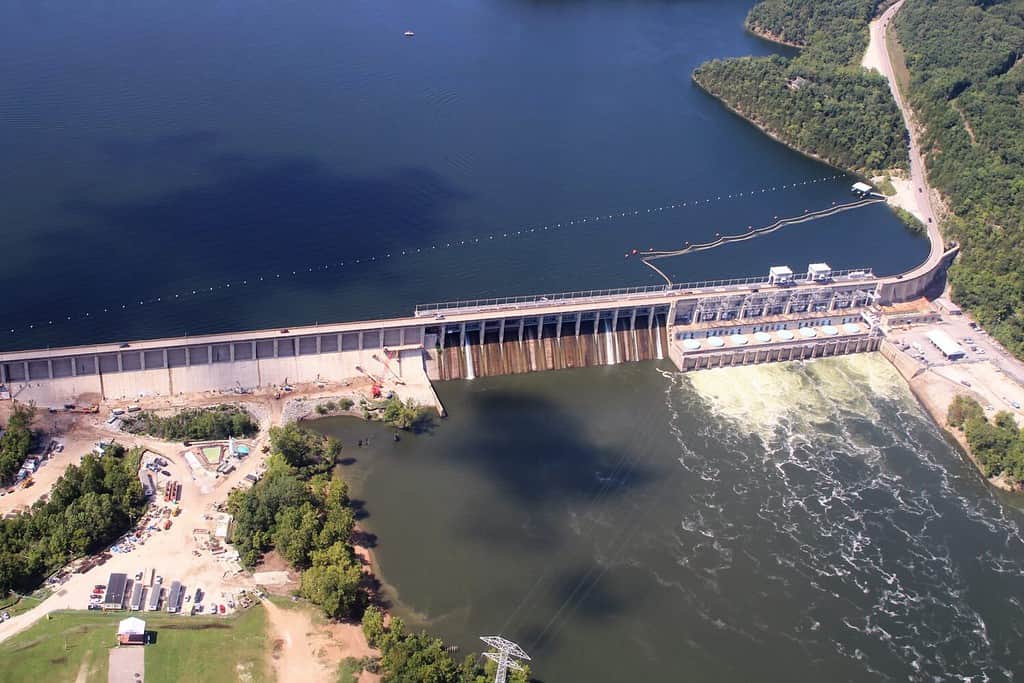
The Bagnell Dam is responsible for the formation of the Lake of the Ozarks.
©Kaleb Tallmage/Shutterstock.com
The Bagnell Dam is responsible for the formation of the Lake of the Ozarks. Construction began in 1929 and finished in April 1931. This dam is 2,543 feet long and 148 feet high. It has earned the informal name of “Osage Dam”. It has a 520-foot spillway and a 511-foot power station, which creates enough energy to power over 40,000 homes.
Wildlife in the Ozarks
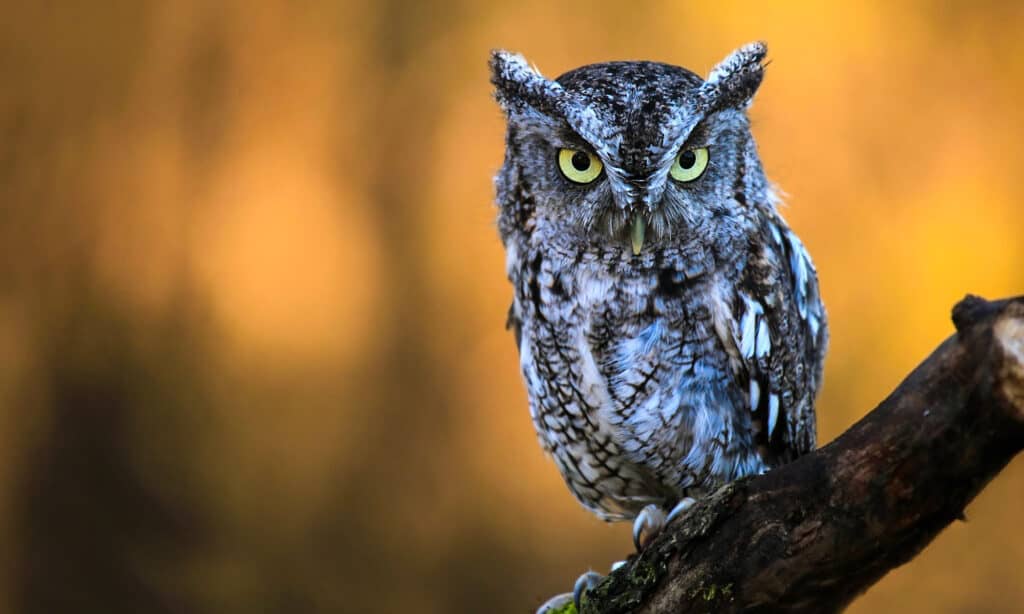
The screech owl is one of many animal species you might find in the area surrounding Lake of the Ozarks.
©mlorenz/Shutterstock.com
The area surrounding Lake of the Ozarks is rich with nature. In the lakes and rivers, you can sight otters, muskrats, and beavers. In the mountains, you may encounter white-tail deer, black bears, and squirrels. Bats haunt the mountain caves, and channel catfish swim under the waters that run through the Ozarks. Snakes are also populous – watch out for cottonmouths, timber rattlesnakes, and milk snakes, along with many others. Maybe you’ll spot an Ozark zigzag salamander, or hear the calls of screech owls and mockingbirds.
For animal viewing, the Lake of the Ozarks and its surrounding mountains are ideal, and much tourism to the area revolves around this factor.
Tourism and Recreation
There is so much to do when you visit the Ozarks and go down to the waters of the lake! Resorts around the lake offer world-class boating, golfing, and lodging. Many people visit for fishing, whether solo or on fishing tours. A variety of fishing guide services and tours surround the lake, helping avid fishers learn where to fish, and what fish they’ll catch, and introduce them to other fishermen.
On the adventure side, Bridal Cave/Thunder Mountain Park is one of the most scenic caves in the United States and draws visitors from all over the world. You can also visit Stark Caverns, an 85 percent wheelchair-accessible cave system by the Lake of the Ozarks.
For adrenaline-seekers, three or more zipline tours exist on the lake.
You can find lodging at a resort, or you can choose rustic camping at a series of RV Parks, small cabins, and dispersed campgrounds throughout the area. Missouri prides itself on offering camping and recreation opportunities to everyone, including people on a budget. So, whether you’re looking for all-inclusive resorts or hoping for something a bit more modest, you’re sure to find a good place to lay your head.
Beaches at Lake of the Ozarks
There are only two public swimming beaches at Lake of the Ozarks. They are both “swim-at-your-own-risk” beaches and do not allow pets. Amenities at both locations include picnic tables, reservable shelters, and playgrounds.
Public Beach #1 is open from May 26th to September 4th and is located at 257 Public Beach Drive west of Brumley, Missouri.
Grand Glaize Beach is open from May 26th to September 4th and is located in the Lake of the Ozarks State Park in Kaiser, Missouri.
There are other places to dip your toes in the water, but these two beaches are the main swimming spots for visitors to the area.
Thank you for reading! Have some feedback for us? Contact the AZ Animals editorial team.

